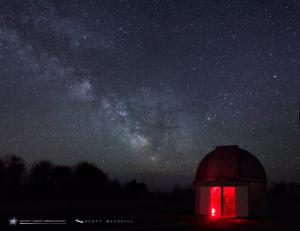
Public Stargazing
- Where:
- Frosty Drew Observatory
- When:
- Friday July 3, 2015 at 6:00 p.m.
- Cost:
- $1 Suggested Donation per Person
Tonight's forecast is quite conflicting, as usual. We can generally expect partly cloudy skies with periods of clearings. Our most reliable forecast source is calling for haze moving in around 8:00p.m.. The bright 84% waning gibbous Moon will rise just before 11:00 p.m. offering us a bout of super dark skies. Haze alone will not hinder our viewings of Venus, Jupiter, Saturn and the Moon, but if skies actually become partly cloudy, we will attempt viewings of objects between passing clouds. Additionally, the conjunction of Venus and Jupiter will continue through the weekend as Jupiter slowly moves further along to the West. Though some forecasts are calling for clouds, tonight could turn out OK.
We plan to open the Observatory and Sky Theatre at 6:00 p.m. In the Observatory we will showcase live views of the solar photosphere if skies permit, showcasing growing Sunspot 2373. Otherwise, we will show archived footage of the photosphere from previous weeks at Frosty Drew. Once the Sun sets, we will point our telescopes towards Venus and Jupiter which will be putting on their celestial dance in the western twilight sky. Shortly after, Saturn will be on display in the primary telescope for the enjoyment of all. The Nature Center will open from 7:00 p.m. - 10:00 p.m. with Naturalists on hand to showcase the brighter side of Frosty Drew. The Sky Theatre will feature an astrophoto showcase of images shot at Frosty Drew. We will continue until near midnight unless clouds kick us out or we rock out later.
Overall, tonight's forecast is quite variable though the night could turn out quite well if clouds stay away. We have seen some rough nights at Frosty Drew Observatory this summer, though it appears that we may be moving out of the thick. Twitter and Facebook are your friends and will keep you updated on what is happening at Frosty Drew Observatory tonight. So set your holiday weekend sites on the stars and make tonight the night that you become acquainted with the cosmos and set your inner geek free.
-------------------------------------------------------------------------
Weekly Happenings
Scott MacNeill
This coming Monday, June 6, Earth will reach the point in its orbit when it is the furthest from the Sun. This is called “Aphelion” and is the opposite of “Perihelion”, when the Earth is closest to the sun in January. Thanks to Johannes Kepler, we now know that the planets to not have perfectly circular orbits around the Sun. This offset is called “eccentricity”. During aphelion, Earth is 3,168,993 miles further from the Sun than it is at perihelion in the winter. At aphelion the Earth is 94,821,244 miles distant from the Sun, compared to perihelion when the Earth is only 91,652,251 miles out. This may sound weird to most northern hemisphere readers since this occurs during the steamy summer month of July, but changes in Earth's distance from the Sun is not the mechanism that gives us seasons. The 23.4° axial tilt of Earth, which will bring direct sunlight to either the northern hemisphere or the southern hemisphere, depending on Solstice, is what triggers Earth's seasons. So step outside this Monday and feel the burn as we are at our furthest point from the Sun.
Save the Date: NASA New Horizons is closing in on dwarf planet Pluto and will be at its closest point on Tuesday, July, 14th. Get involved at NASA New Horizons
-Scott
